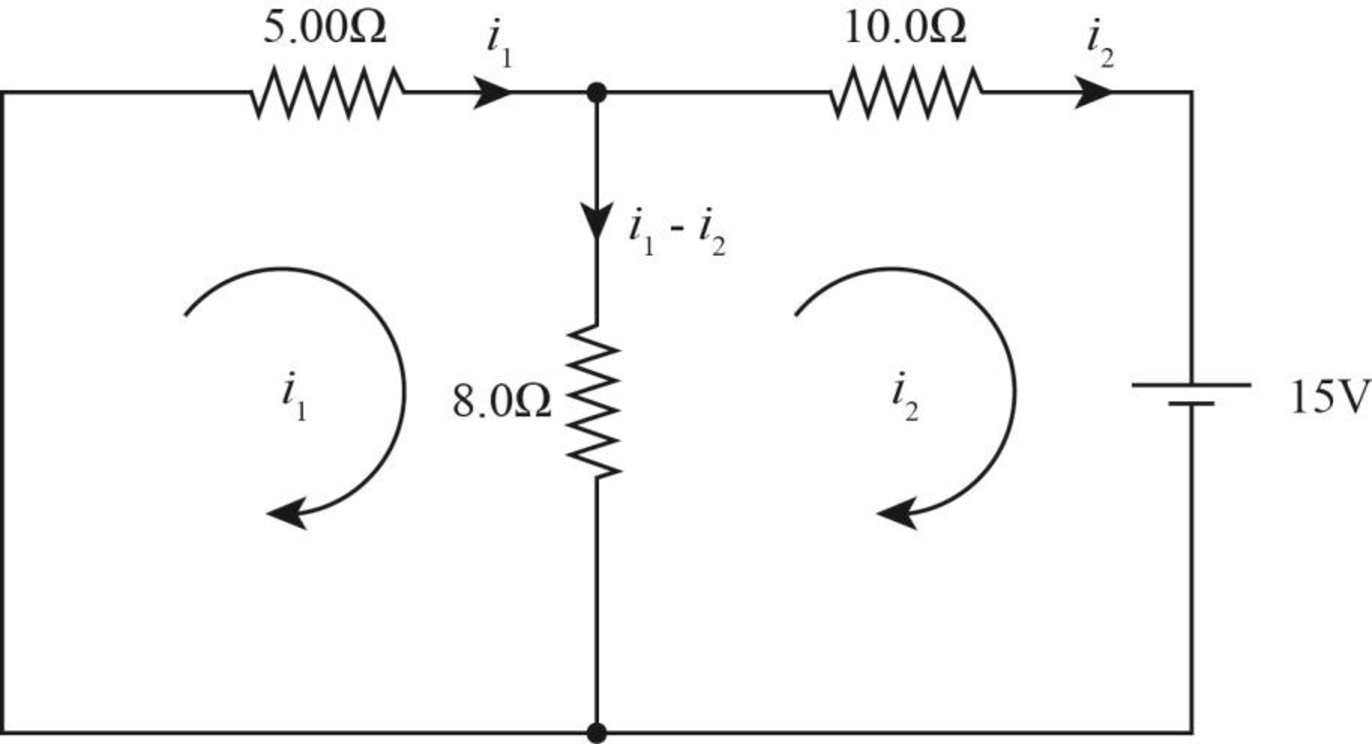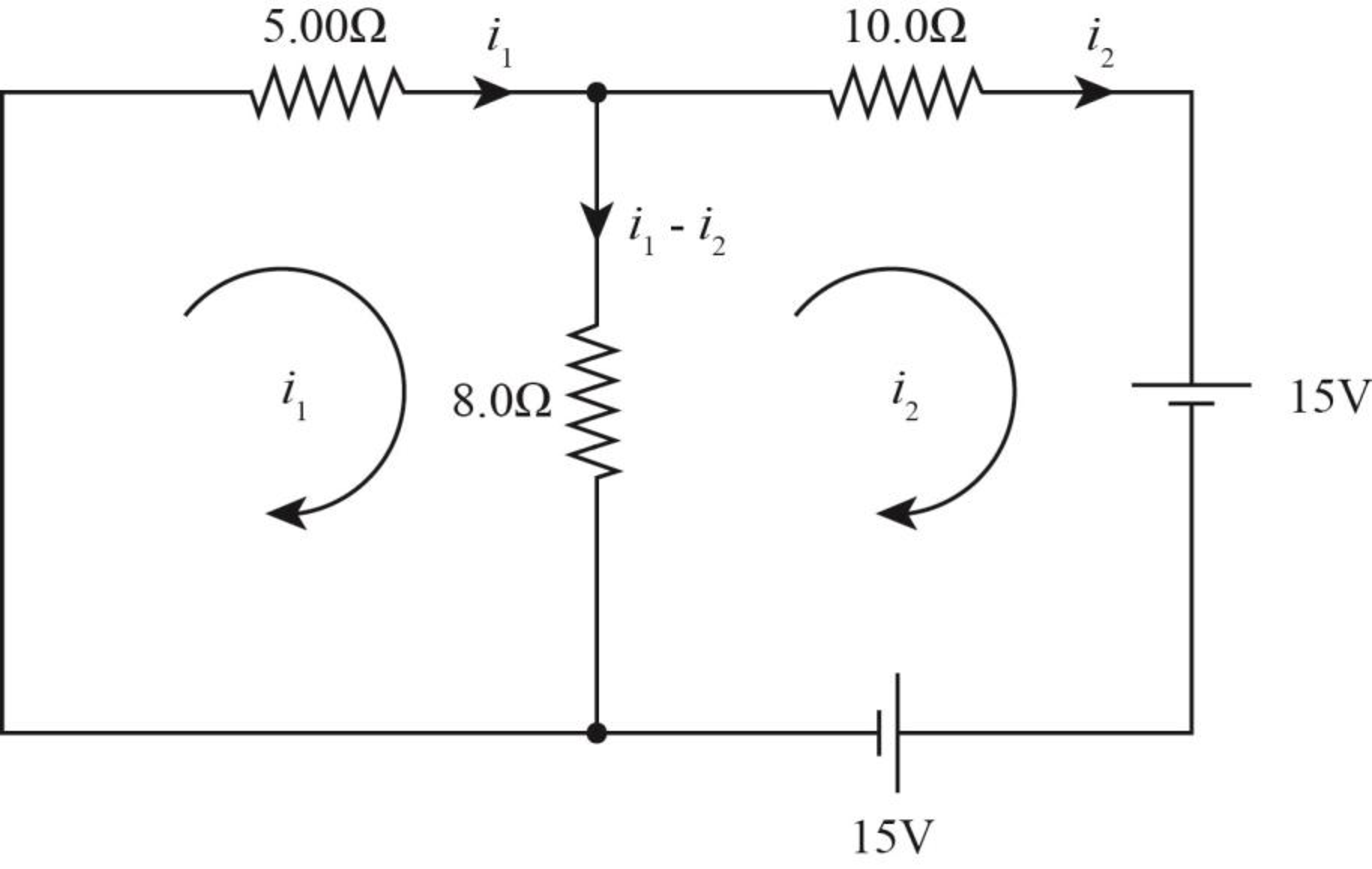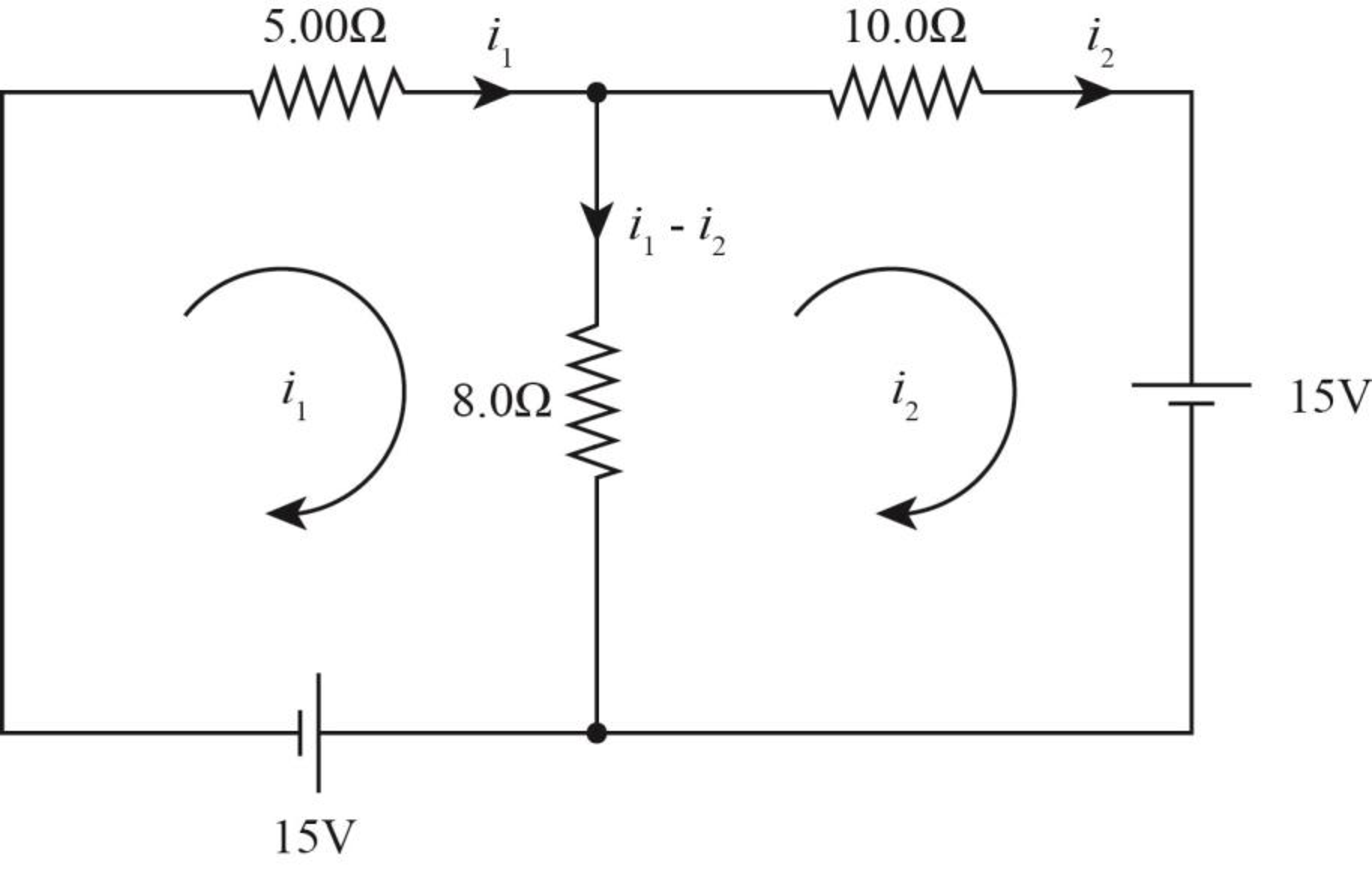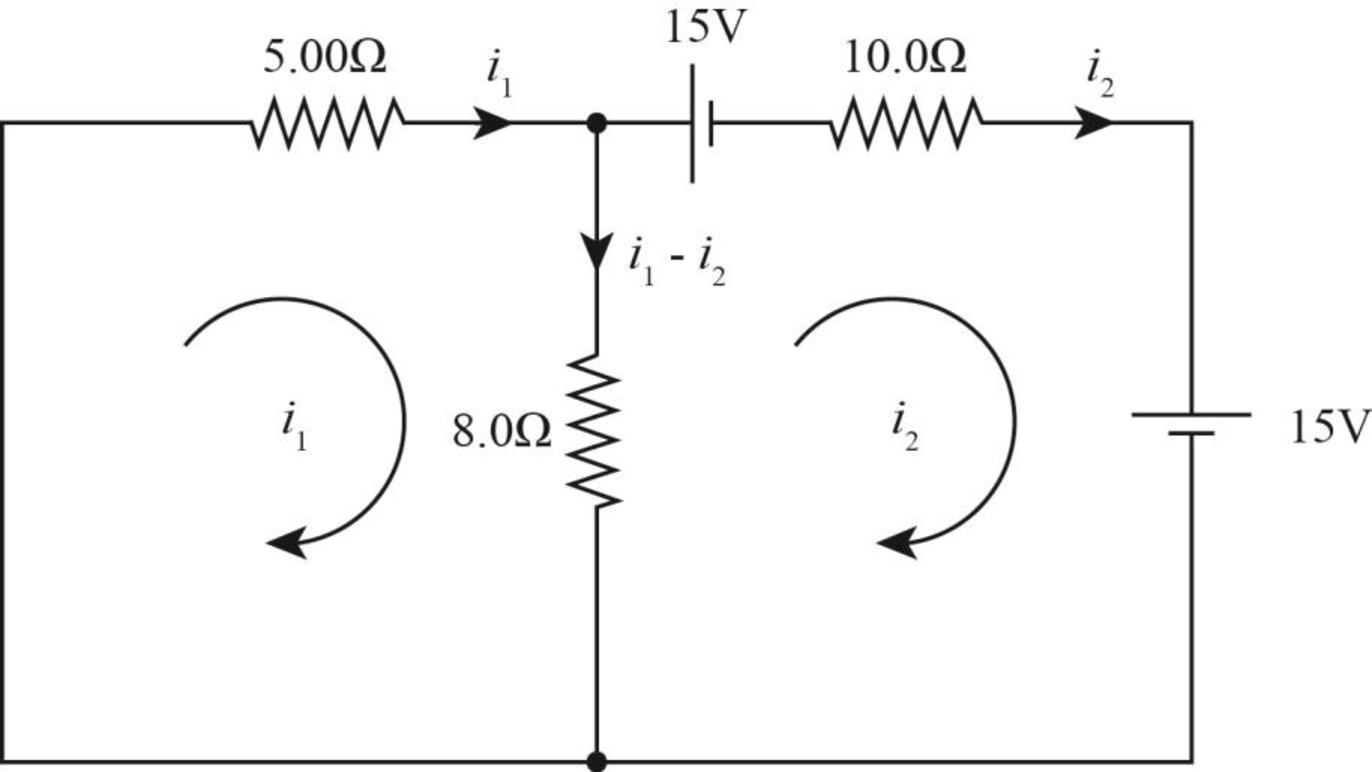
(a)
The current in the
(a)
Answer to Problem 54AP
The current in
Explanation of Solution
Write the expression based on the junction rule.
Here,
Write the expression to obtain the loop rule.
Here,
Write the expression for the potential difference based on Ohm’s law.
Here,
The flow of current in the circuit is as shown in the figure below.

Figure-(1)
Here,
Write the equation of Kirchhoff’s voltage rule in the left loop.
Write the equation of Kirchhoff’s voltage rule in the right loop.
Conclusion:
Solve equation (I) and (II) to calculate
Therefore, the current in
(b)
The power delivered to the
(b)
Answer to Problem 54AP
The power delivered to the
Explanation of Solution
Write the expression to obtain the power across the
Here,
Conclusion:
Substitute
Therefore, the power delivered to the
(c)
The circuit in which Kirchhoff’s rule is required in find the value of current.
(c)
Answer to Problem 54AP
The Kirchhoff’s rule is required to find the value of current in case of circuit (c).
Explanation of Solution
In case of circuit (c), the current is flowing across each resistor and voltage drops at each resistor. As both the batteries of same emf are not in the same loop, thus, some amount of current will flow in the circuit. Hence, Kirchhoff’s rule is applicable in this case.
Conclusion:
In the case of the other two circuits, both the batteries of same emf are in the same loop. Thus they cancel out each other and no current flow in the circuit (b) and circuit (d).
Therefore, The Kirchhoff’s rule is required in find the value of current in case of circuit (c).
(d)
The circuit in which the smallest amount of power is delivered to the
(d)
Answer to Problem 54AP
The smallest power is delivered across the
Explanation of Solution
Conclusion:
The current flow diagram for circuit (b) is as shown in the figure below.

Figure-(2)
Write the equation of Kirchhoff’s voltage rule in right loop.
Write the expression based on junction rule.
Solve equation (III) and (IV) to calculate
Thus, the current across the circuit (b) is zero.
Therefore, the power delivered to across
The current flow diagram for circuit (c) is as shown in the figure below.

Figure-(3)
Write the equation of Kirchhoff’s voltage rule in the left loop.
Write the equation of Kirchhoff’s voltage rule in the left loop.
Solve equation (V) and (VI) to calculate
Write the expression to obtain the power across the
Here,
Substitute
Therefore, the power delivered to the
The current flow diagram for circuit (d) is as shown in the figure below.

Figure-(4)
Write the equation of Kirchhoff’s voltage rule in left loop.
Write the equation of Kirchhoff’s voltage rule in left loop.
Solve equation (VII) and (VIII) to calculate
Thus, the current across the circuit (d) is zero.
Therefore, the power delivered to across
Therefore the smallest power is delivered across
Want to see more full solutions like this?
Chapter 28 Solutions
Physics for Scientists and Engineers with Modern, Revised Hybrid (with Enhanced WebAssign Printed Access Card for Physics, Multi-Term Courses)
- Please see the attached image and answer the set of questions with proof.arrow_forwardHow, Please type the whole transcript correctly using comma and periods as needed. I have uploaded the picture of a video on YouTube. Thanks,arrow_forwardA spectra is a graph that has amplitude on the Y-axis and frequency on the X-axis. A harmonic spectra simply draws a vertical line at each frequency that a harmonic would be produced. The height of the line indicates the amplitude at which that harmonic would be produced. If the Fo of a sound is 125 Hz, please sketch a spectra (amplitude on the Y axis, frequency on the X axis) of the harmonic series up to the 4th harmonic. Include actual values on Y and X axis.arrow_forward
- Sketch a sign wave depicting 3 seconds of wave activity for a 5 Hz tone.arrow_forwardSketch a sine wave depicting 3 seconds of wave activity for a 5 Hz tone.arrow_forwardThe drawing shows two long, straight wires that are suspended from the ceiling. The mass per unit length of each wire is 0.050 kg/m. Each of the four strings suspending the wires has a length of 1.2 m. When the wires carry identical currents in opposite directions, the angle between the strings holding the two wires is 20°. (a) Draw the free-body diagram showing the forces that act on the right wire with respect to the x axis. Account for each of the strings separately. (b) What is the current in each wire? 1.2 m 20° I -20° 1.2 marrow_forward
- 2). How much energy is stored in the 50-μF capacitor when Va - V₁ = 22V? 25 µF b 25 µF 50 µFarrow_forward9). A series RC circuit has a time constant of 1.0 s. The battery has a voltage of 50 V and the maximum current just after closing the switch is 500 mA. The capacitor is initially uncharged. What is the charge on the capacitor 2.0 s after the switch is closed? R 50 V a. 0.43 C b. 0 66 C c. 0.86 C d. 0.99 C Carrow_forward1). Determine the equivalent capacitance of the combination shown when C = 12 pF. +11/20 2C C Carrow_forward
 Physics for Scientists and Engineers: Foundations...PhysicsISBN:9781133939146Author:Katz, Debora M.Publisher:Cengage Learning
Physics for Scientists and Engineers: Foundations...PhysicsISBN:9781133939146Author:Katz, Debora M.Publisher:Cengage Learning Principles of Physics: A Calculus-Based TextPhysicsISBN:9781133104261Author:Raymond A. Serway, John W. JewettPublisher:Cengage Learning
Principles of Physics: A Calculus-Based TextPhysicsISBN:9781133104261Author:Raymond A. Serway, John W. JewettPublisher:Cengage Learning Physics for Scientists and Engineers, Technology ...PhysicsISBN:9781305116399Author:Raymond A. Serway, John W. JewettPublisher:Cengage Learning
Physics for Scientists and Engineers, Technology ...PhysicsISBN:9781305116399Author:Raymond A. Serway, John W. JewettPublisher:Cengage Learning College PhysicsPhysicsISBN:9781305952300Author:Raymond A. Serway, Chris VuillePublisher:Cengage Learning
College PhysicsPhysicsISBN:9781305952300Author:Raymond A. Serway, Chris VuillePublisher:Cengage Learning College PhysicsPhysicsISBN:9781285737027Author:Raymond A. Serway, Chris VuillePublisher:Cengage Learning
College PhysicsPhysicsISBN:9781285737027Author:Raymond A. Serway, Chris VuillePublisher:Cengage Learning Physics for Scientists and Engineers with Modern ...PhysicsISBN:9781337553292Author:Raymond A. Serway, John W. JewettPublisher:Cengage Learning
Physics for Scientists and Engineers with Modern ...PhysicsISBN:9781337553292Author:Raymond A. Serway, John W. JewettPublisher:Cengage Learning





